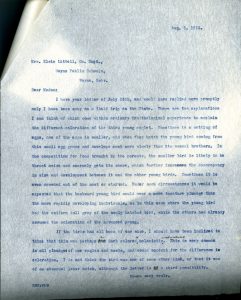Great Nebraska
Naturalists and ScientistsNOU, Myron Swenk, Letter, 1913, Aug. 5
 Aug. 5, 1913.
Aug. 5, 1913.
Mrs. Elsie Littell, Co. Supt., Wayne Public Schools, Wayne, Nebr.
Dear Madam: I have your letter of July 26th, and would have replied more promptly only I have been away on a field trip in the State. There are two explanations I can think of which come within ordinary Ornithological experience to explain the different coloration of the third young eaglet. Sometimes in a setting of eggs, one of the eggs is smaller, and when they hatch the young bird coming from this small egg grows and develops much more slowly than its normal brothers. In the competition for food brought by the parents, the smaller bird is likely to be thrust aside and scarcely gets its share, which further increases the descrepancy in size and development between it and the other young birds. Sometimes it is even crowded out of the nest or starved. Under such circumstances it would be expected that the backward young bird would wear a more immature plumage than the more rapidly developing individuals, as is this case where the young bird had the uniform dull gray of the newly hatched bird, while the others had already assumed the coloration of the advanced young. If the birds had all been of one size, I should have been inclined to think that this one was perhaps a dark colored, melanistic, individual. This is very common in all plumages of our eagles and hawks, and would account for the difference in coloration. I do not think the bird was one of some other kind, or that it was of an abnormal later hatch, although the latter is a third possibility. Yours very truly,
MHS:RNB